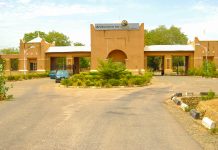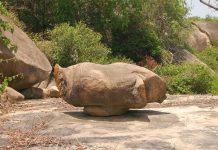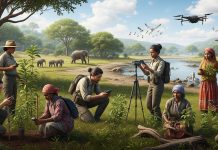Malam Musa Kawuwa, 50, a tailor, lives with his two wives and 10 children in a four-bedroom house he inherited from his late father at the Jauro Musa area in Kumo town of Akko Local Government Area of Gombe State. Sometime in 2014, the whole house was submerged by gully erosion following torrential rain, leaving Kawuwa and his family of 13 homeless.
They lost all their belongings. To worsen the situation, his farmland of about 10 hectares was also affected by the gully erosion. He cultivates both food and cash crops from the farm annually to feed his family and supplement what he gets from tailoring. Having lost his major means of livelihood, it took him over four years to rebuild the house, after squatting in a two-bedroom apartment for over three years.
Read also: NESREA commends Gombe government for 3G initiative
Not long after he returned to his house, the erosion is still threatening to consume his property. “Few months after I returned to my house, erosion is still lurking. “And if nothing is done to address the situation, I may have to relocate again because, as I am speaking with you, the wall of my house is at the verge of collapsing,” Kawuwa lamented. Kawuwa’s story is similar to hundreds of others in the Unguwar Jauro Musa area of Kumo town, where over the years, an estimated 300 hectares of farmlands and hundreds of people have left their ancestral homes due to the menace of erosion. Over a period of 20 years, an estimated 75 percent of the total landmass of Gombe State is affected by varying degrees of desertification.
Investigations revealed that in the 11 local government areas of the state, the problem is more severe in Akko, Nafada, Dukku, Funakaye and Kwami, Gombe and Yamaltu/Deba. In an effort to address the gully erosion and other ecological problems facing the state, Governor Muhammad Inuwa Yahaya introduced an environmental restoration project, the Gombe Goes Green Project (3G), to, among other things, combat desert encroachment, stop or reduce deforestation, restore biodiversity and reduce the negative effects of climate change. The coordinator of the 3G project, Dr. Mu’azu Usman Shehu, said it sought to restore the environment through the massive establishment of new forests and woodlands.

“The 3G seeks to achieve the objectives of the project through afforestation, that is the establishment of new forests and woodlands, restoration of degraded forests and woodlands, and by allowing natural regeneration. We also seek to restore biodiversity by reintroducing a broad range of indigenous tree species, with emphasis on species facing extinction; promoting sustainable development by growing exotic fruit-bearing trees that benefit local people, especially in rural areas; increasing societal awareness of human-induced ecological problems and solutions,” he said.
According to him, the government has set an ambitious target of planting four million assorted tree species in the next four years in the 11 local government areas of the state. “That is, we are expected to plant one million trees every year,” he said.
Dr Shehu added that the 3G is a holistic environmental restoration and conservation project, which is carefully tailored to address the peculiar environmental challenges in the state. He said the state government introduced the 3G project because desert encroachment is approaching the state at an alarming rate and affecting its forest resources every year. “We are alarmed that Gombe is one of the frontline states affected by a myriad of environmental challenges.
Major among these challenges is desertification, which, according to available evidence, is encroaching at an alarming rate of more than 0.6km annually. Another serious ecological problem affecting our state is severe gully erosion, which has devastating consequences on our economy. And our society being agrarian, the huge economic and social impacts range from resource scarcity to decline in agricultural yield, poverty, population migration, and conflicts,” Dr. Shehu said. The coordinator added that Governor Yahaya recognized the urgent need to combat land degradation and address the negative effects of climate change in the state. “That is why he introduced an environmental restoration program as soon as he was sworn into office,” he recalled. According to him, the 3G project, in collaboration with the state Ministry of Environment and Forest Resources, has raised 1.5 million seedlings of assorted improved tree species for the 2020 tree planting season.

He said, “The 3G project has revived existing nurseries throughout the state, and three of these nurseries in Gombe, Kwadon and Hashidu are being used to raise 1.2 million seedlings.” We have also engaged the Federal College of Horticulture, Dadinkowa to raise 300,000 seedlings of fruit-bearing trees for the project. So far, we have achieved 65 percent of the target.” Dr. Shehu further said they were going to use 150,000 seedlings to establish six woodlots, two in each of the three senatorial zones of the state.
He added that they have urban planting, which includes roadside planting and planting in public buildings like hospitals and government buildings. “About 300,000 seedlings will be used for urban planting. The last category is what is called social forestry, where about 500,000 seedlings will be planted in schools and places of worship. We have also made enough provision of seedlings for free distribution to individuals to plant in their homes and places of occupation, as well as to farmers who want to improve soil nutritional cycle in their farms,” he added.

















